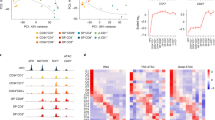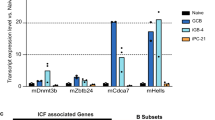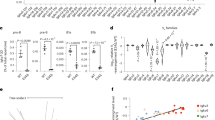Key Points
-
The immune-receptor loci are opened up and made accessible to the recombination machinery through a stepwise process that removes sequential layers of gene-repression mechanisms.
-
This process involves changes in replication timing, nuclear positioning, histone modification, heterochromatization and DNA methylation.
-
Allelic exclusion is mediated by a mechanism that is initiated in the early embryo when the two alleles become asynchronously replicating.
-
During B-cell development, one immunoglobulin light-chain (IgL) allele in each cell is packaged in an open nucleosome structure, which is characterized by histone acetylation, whereas the other is kept inaccessible by being heterochromatized.
-
DNA demethylation occurs preferentially on the acetylated IgL κ-allele, and this renders the locus accessible for primary recombination and, if required, secondary editing events.
-
In the absence of functional immunoglobulin, the second locus can still undergo epigenetic opening and become a substrate for recombination.
-
Monoallelic selection is characteristic of other multi-gene systems and might function as the basis for gene diversity in other systems.
Abstract
During the differentiation of T and B cells, immune-receptor loci in the genome must be made sterically accessible so that they can undergo rearrangement. Here, we discuss how this is carried out by the stepwise removal of epigenetic repression mechanisms — such as later-replication timing, heterochromatization, histone hypo-acetylation and DNA methylation — in a manner that initially favours one allele in each cell. We propose that this mechanism of allelic exclusion might also be the basis for the generation of gene diversity in other systems.
This is a preview of subscription content, access via your institution
Access options
Subscribe to this journal
Receive 12 print issues and online access
$209.00 per year
only $17.42 per issue
Buy this article
- Purchase on SpringerLink
- Instant access to full article PDF
Prices may be subject to local taxes which are calculated during checkout



Similar content being viewed by others
References
Pernis, B., Chiappino, G., Kelus, A. S. & Gell, P. G. Cellular localization of immunoglobulins with different allotypic specificities in rabbit lymphoid tissues. J. Exp. Med. 122, 853–876 (1965).
Sonoda, E. et al. B cell development under the condition of allelic inclusion. Immunity 6, 225–233 (1997).
Nemazee, D. & Hogquist, K. A. Antigen receptor selection by editing or downregulation of V(D)J recombination. Curr. Opin. Immunol. 15, 182–189 (2003).
Khorasanizadeh, S. The nucleosome: from genomic organization to genomic regulation. Cell 116, 259–272 (2004).
Martens, J. A. & Winston, F. Recent advances in understanding chromatin remodeling by Swi/Snf complexes. Curr. Opin. Genet. Dev. 13, 136–142 (2003).
Ahmad, K. & Henikoff, S. The histone variant H3.3 marks active chromatin by replication-independent nucleosome assembly. Mol. Cell 9, 1191–1200 (2002).
Iizuka, M. & Smith, M. M. Functional consequences of histone modifications. Curr. Opin. Genet. Dev. 13, 154–160 (2003).
Jenuwein, T. & Allis, C. D. Translating the histone code. Science 293, 1074–1080 (2001).
Fischle, W., Wang, Y. & Allis, C. D. Binary switches and modification cassettes in histone biology and beyond. Nature 425, 475–479 (2003).
Yancopoulos, G. D. & Alt, F. W. Developmentally controlled and tissue-specific expression of unrearranged VH gene segments. Cell 40, 271–281 (1985).
Yancopoulos, G. D., Blackwell, T. K., Suh, H., Hood, L. & Alt, F. W. Introduced T cell receptor variable region gene segments recombine in pre-B cells: evidence that B and T cells use a common recombinase. Cell 44, 251–259 (1986).
Stanhope-Baker, P., Hudson, K. M., Shaffer, A. L., Constantinescu, A. & Schlissel, M. S. Cell type-specific chromatin structure determines the targeting of V(D)J recombinase activity in vitro. Cell 85, 887–897 (1996).
Goren, A. & Cedar, H. Replicating by the clock. Nature Rev. Mol. Cell Biol. 4, 25–32 (2003).
Mostoslavsky, R. et al. Asynchronous replication and allelic exclusion in the immune system. Nature 414, 221–225 (2001). The process of allelic exclusion might begin early in development, at the time of embryo implantation, when the genes that encode the antigen receptors become asynchronously replicating in each cell. This was the first paper to indicate that this epigenetic event is established randomly, is clonally inherited and seems to provide a signalling mechanism for preferentially directing the initial rearrangement to the allele that replicates early.
Kosak, S. T. et al. Subnuclear compartmentalization of immunoglobulin loci during lymphocyte development. Science 296, 158–162 (2002). This paper was the first to show that the immunoglobulin-gene loci change their spatial position in the nucleus as a function of B-cell differentiation. Subnuclear positioning might regulate transcription, as well as V(D)J recombination.
Chowdhury, D. & Sen, R. Stepwise activation of the immunoglobulin μ heavy chain gene locus. EMBO J. 20, 6394–6403 (2001). This paper provided a plausible explanation for the order of rearrangement at the IgH locus. The authors found that V H gene segments are not associated with hyperacetylated histones in bone marrow pro-B cells, whereas D H , J H and Cμ gene regions are.
Johnson, K., Angelin-Duclos, C., Park, S. & Calame, K. L. Changes in histone acetylation are associated with differences in accessibility of VH gene segments to V–DJ recombination during B-cell ontogeny and development. Mol. Cell. Biol. 23, 2438–2450 (2003).
Maës, J. et al. Chromatin remodeling at the Ig loci prior to V(D)J recombination. J. Immunol. 167, 866–874 (2001).
Chowdhury, D. & Sen, R. Transient IL-7/IL-7R signaling provides a mechanism for feedback inhibition of immunoglobulin heavy chain gene rearrangements. Immunity 18, 229–241 (2003).
Martin, D. J. & van Ness, B. G. Initiation and processing of two κ immunoglobulin germ line transcripts in mouse B cells. Mol. Cell. Biol. 10, 1950–1958 (1990).
Singh, N., Bergman, Y., Cedar, H. & Chess, A. Biallelic germline transcription at the κ immunoglobulin locus. J. Exp. Med. 197, 743–750 (2003).
Bolland, D. J. et al. Antisense intergenic transcription in V(D)J recombination. Nature Immunol. 5, 630–637 (2004).
Morshead, K. B., Ciccone, D. N., Taverna, S. D., Allis, C. D. & Oettinger, M. A. Antigen receptor loci poised for V(D)J rearrangement are broadly associated with BRG1 and flanked by peaks of histone H3 dimethylated at lysine 4. Proc. Natl Acad. Sci. USA 100, 11577–11582 (2003).
Busslinger, M. Transcriptional control of early B cell development. Annu. Rev. Immunol. 22, 55–79 (2004).
Fuxa, M. et al. Pax5 induces V-to-DJ rearrangements and locus contraction of the immunoglobulin heavy-chain gene. Genes Dev. 18, 411–422 (2004). This report showed that PAX5 activates locus contraction and distal V H -to-DJ H rearrangements in pro-B cells. An unknown factor that is present in pro-B cells collaborates with PAX5 in these processes.
Hesslein, D. G. et al. Pax5 is required for recombination of transcribed, acetylated, 5′ IgH V gene segments. Genes Dev. 17, 37–42 (2003).
Brown, K. E., Baxter, J., Graf, D., Merkenschlager, M. & Fisher, A. G. Dynamic repositioning of genes in the nucleus of lymphocytes preparing for cell division. Mol. Cell 3, 207–217 (1999).
Azuara, V. et al. Heritable gene silencing in lymphocytes delays chromatid resolution without affecting the timing of DNA replication. Nature Cell Biol. 5, 668–674 (2003).
Sabbattini, P. et al. Binding of Ikaros to the λ5 promoter silences transcription through a mechanism that does not require heterochromatin formation. EMBO J. 20, 2812–2822 (2001).
Brown, K. E. et al. Association of transcriptionally silent genes with Ikaros complexes at centromeric heterochromatin. Cell 91, 845–854 (1997).
Skok, J. A. et al. Nonequivalent nuclear location of immunoglobulin alleles in B lymphocytes. Nature Immunol. 2, 848–854 (2001).
Goldmit, M. & Bergman, Y. Monoallelic gene expression: a repertoire of recurrent themes. Immunol. Rev. 200, 197–214 (2004).
Liang, H. -E., Hsu, L. -Y., Cado, D. & Schlissel, M. S. Variegated transcriptional activation of the immunoglobulin κ locus in pre-B cells contributes to the allelic exclusion of light-chain expression. Cell 118, 19–29 (2004).
Zhou, J., Ermakova, O. V., Riblet, R., Birshtein, B. K. & Schildkraut, C. L. Replication and subnuclear location dynamics of the immunoglobulin heavy-chain locus in B-lineage cells. Mol. Cell. Biol. 22, 4876–4889 (2002).
Gasser, S. M. Positions of potential: nuclear organization and gene expression. Cell 104, 639–642 (2001).
Gilbert, D. M. Replication timing and transcriptional control: beyond cause and effect. Curr. Opin. Cell Biol. 14, 377–383 (2002).
Dimitrova, D. S. & Gilbert, D. M. The spatial position and replication timing of chromosomal domains are both established in early G1 phase. Mol. Cell 4, 983–993 (1999).
Jaenisch, R. & Bird, A. Epigenetic regulation of gene expression: how the genome integrates intrinsic and environmental signals. Nature Genet. 33, 245–254 (2003).
Cedar, H. & Bergman, Y. Developmental regulation of immune system gene rearrangement. Curr. Opin. Immunol. 11, 64–80 (1999).
Bergman, Y., Fisher, A. G. & Cedar, H. Epigenetic mechanisms that regulate antigen receptor gene expression. Curr. Opin. Immunol. 15, 176–181 (2003).
Hsieh, C. L. & Lieber, M. R. CpG methylated minichromosomes become inaccessible for V(D)J recombination after undergoing replication. EMBO J. 11, 315–325 (1992).
Engler, P. et al. A strain-specific modifier on mouse chromosome 4 controls the methylation of independent transgene loci. Cell 65, 939–947 (1991).
Cherry, S. R. & Baltimore, D. Chromatin remodeling directly activates V(D)J recombination. Proc. Natl Acad. Sci. USA 96, 10788–10793 (1999).
Mostoslavsky, R. et al. κ chain monoallelic demethylation and the establishment of allelic exclusion. Genes Dev. 12, 1801–1811 (1998). This paper showed that the κ-chain gene is fully methylated on both alleles early in lymphoid development, but it undergoes monoallelic demethylation in pre-B cells before rearrangement. This was the first report that epigenetic modifications underlie the process of allelic exclusion.
Baumann, M., Mamais, A., McBlane, F., Xiao, H. & Boyes, J. Regulation of V(D)J recombination by nucleosome positioning at recombination signal sequences. EMBO J. 22, 5197–5207 (2003).
Kwon, J., Morshead, K. B., Guyon, J. R., Kingston, R. E. & Oettinger, M. A. Histone acetylation and hSWI/SNF remodeling act in concert to stimulate V(D)J cleavage of nucleosomal DNA. Mol. Cell 6, 1037–1048 (2000).
Guo, J. et al. Regulation of the TCRα repertoire by the survival window of CD4+CD8+ thymocytes. Nature Immunol. 3, 469–476 (2002).
Ahmad, K. & Henikoff, S. Epigenetic consequences of nucleosome dynamics. Cell 111, 281–284 (2002).
Korber, P. & Horz, W. SWRred not shaken; mixing the histones. Cell 117, 5–7 (2004).
Chen, H. T. et al. Response to RAG-mediated VDJ cleavage by NBS1 and γ-H2AX. Science 290, 1962–1965 (2000).
Redon, C. et al. Histone H2A variants H2AX and H2AZ. Curr. Opin. Genet. Dev. 12, 162–169 (2002).
Bassing, C. H. et al. Histone H2AX: a dosage-dependent suppressor of oncogenic translocations and tumors. Cell 114, 359–370 (2003).
Celeste, A. et al. Histone H2AX phosphorylation is dispensable for the initial recognition of DNA breaks. Nature Cell Biol. 5, 675–679 (2003).
Goldmit, M., Schlissel, M., Cedar, H. & Bergman, Y. Differential accessibility at the κ chain locus plays a role in allelic exclusion. EMBO J. 21, 5255–5261 (2002).
Krangel, M. S. Gene segment selection in V(D)J recombination: accessibility and beyond. Nature Immunol. 4, 624–630 (2003).
Kirillov, A. et al. A role for nuclear NF-κB in B-cell-specific demethylation of the Igκ locus. Nature Genet. 13, 435–441 (1996).
Ji, Y., Zhang, J., Lee, A. I., Cedar, H. & Bergman, Y. A multistep mechanism for the activation of rearrangement in the immune system. Proc. Natl Acad. Sci. USA 100, 7557–7562 (2003).
Sleckman, B. P., Gorman, J. R. & Alt, F. W. Accessibility control of antigen-receptor variable-region gene assembly: role of cis-acting elements. Ann. Rev. Immunol. 14, 459–481 (1996).
Gay, D., Saunders, T., Camper, S. & Weigert, M. Receptor editing: an approach by autoreactive B cells to escape tolerance. J. Exp. Med. 177, 999–1008 (1993).
Tiegs, S. L., Russell, D. M. & Nemazee, D. Receptor editing in self-reactive bone marrow B cells. J. Exp. Med. 177, 1009–1020 (1993).
Radic, M. Z., Erikson, J., Litwin, S. & Weigert, M. B lymphocytes may escape tolerance by revising their antigen receptors. J. Exp. Med. 177, 1165–1173 (1993).
Casellas, R. et al. Contribution of receptor editing to the antibody repertoire. Science 291, 1541–1544 (2001).
Melamed, D., Benschop, R. J., Cambier, J. C. & Nemazee, D. Developmental regulation of B lymphocyte immune tolerance compartmentalizes clonal selection from receptor selection. Cell 92, 173–182 (1998). This paper showed that secondary gene rearrangement occurs often in mice. Reference 65 reported similar results for human B cells.
Nemazee, D. Receptor editing in B cells. Adv. Immunol. 74, 89–126 (2000).
Brauninger, A., Goossens, T., Rajewsky, K. & Kuppers, R. Regulation of immunoglobulin light chain gene rearrangements during early B cell development in the human. Eur. J. Immunol. 31, 3631–3637 (2001).
Constantinescu, A. & Schlissel, M. S. Changes in locus-specific V(D)J recombinase activity induced by immunoglobulin gene products during B cell development. J. Exp. Med. 185, 609–620 (1997).
Chen, C., Luning Prak, E. & Weigert, M. Editing disease-associated autoantibodies. Immunity 6, 97–105 (1997).
Luning-Prak, E. & Weiger, M. Light chain replacement: a new model for antibody gene rearrangement. J. Exp. Med. 182, 541–548 (1995).
Alt, F. W., Enea, V., Bothwell, A. L. & Baltimore, D. Activity of multiple light chain genes in murine myeloma cells producing a single, functional light chain. Cell 21, 1–12 (1980).
Rolink, A. G., Schaniel, C., Andersson, J. & Melchers, F. Selection events operating at various stages in B cell development. Curr. Opin. Immunol. 13, 202–207 (2001).
Schweighoffer, E., Vanes, L., Mathiot, A., Nakamura, T. & Tybulewicz, V. L. Unexpected requirement for ZAP-70 in pre-B cell development and allelic exclusion. Immunity 18, 523–533 (2003).
Meade, J., Tybulewicz, V. L. & Turner, M. The tyrosine kinase Syk is required for light chain isotype exclusion but dispensable for the negative selection of B cells. Eur. J. Immunol. 34, 1102–1110 (2004).
Corcoran, A. E., Riddell, A., Krooshoop, D. & Venkitaraman, A. R. Impaired immunoglobulin gene rearrangement in mice lacking the IL-7 receptor. Nature 391, 904–907 (1998).
Osipovich, O. et al. Targeted inhibition of V(D)J recombination by a histone methyltransferase. Nature Immunol. 5, 309–316 (2004).
Chess, A., Simon, I., Cedar, H. & Axel, R. Allelic inactivation regulates olfactory receptor gene expression. Cell 78, 823–834 (1994).
Bix, M. & Locksley, R. M. Independent and epigenetic regulation of the interleukin-4 alleles in CD4+ T Cells. Science 281, 1352–1354 (1998).
Hollander, G. A. et al. Monoallelic expression of the interleukin-2 locus. Science 279, 2118–2121 (1998).
Naramura, M., Hu, R. J. & Gu, H. Mice with a fluorescent marker for interleukin 2 gene activation. Immunity 9, 209–216 (1998).
Pereira, J. P., Girard, R., Chaby, R., Cumano, A. & Vieira, P. Monoallelic expression of the murine gene encoding Toll-like receptor 4. Nature Immunol. 4, 464–470 (2003).
Held, W., Roland, J. & Raulet, D. H. Allelic exclusion of Ly49-family genes encoding class I MHC-specific receptors on NK cells. Nature 376, 355–358 (1995).
Acknowledgements
Y.B. and H.C. are supported by research grants from the Israel Academy of Sciences and Humanities, and the National Institutes of Health, United States. Y.B. is also supported by the Fifth European Community Framework Programme on Quality of Life and Management of Living Resources. H.C. is also supported by the Israel Cancer Research Fund.
Author information
Authors and Affiliations
Corresponding author
Ethics declarations
Competing interests
The authors declare no competing financial interests.
Glossary
- EPIGENETIC
-
Any heritable influence on the function of a chromosome or gene that is not caused by a change in DNA sequence.
- V(D)J RECOMBINATION
-
Somatic rearrangement of variable (V), diversity (D) and joining (J) regions of the genes that encode antigen receptors, leading to repertoire diversity of both T-cell and B-cell receptors.
- RECOMBINATION SIGNAL SEQUENCE
-
(RSS). Conserved elements that constitute recognition sites for the V(D)J recombinase proteins, which are encoded by the genes recombination-activating gene 1 (RAG1) and RAG2. They consist of a palindromic heptamer that is immediately adjacent to the coding gene segments — V (variable), D (diversity) or J (joining) — and is separated from a relatively conserved nonamer by a 12- or 23-base-pair spacer.
- RECOMBINATION-ACTIVATING GENE (RAG) PROTEINS
-
RAG proteins are involved in creating the double-stranded DNA breaks that are required to produce the rearranged gene segments encoding the complete protein chains of T-cell and B-cell receptors.
- HETEROCHROMATIN
-
A cytologically defined genomic component that contains repetitive DNA, transposable elements, a ribosomal DNA gene cluster and several protein-encoding genes.
- GERMLINE TRANSCRIPTION
-
Transcription of unrearranged antigen-receptor gene loci that begins before or is coincident with their activation. It is not thought to produce functional protein, and the promoter and initiation sites are often lost in the subsequent rearrangement events.
- FLUORESCENCE IN SITU HYBRIDIZATION
-
(FISH). The use of fluorescent probes to visually label specific DNA sequences in the nuclei of cells that are in the interphase or metaphase stages of mitosis.
- CpG ISLANDS
-
Sequences of 0.5–2 kilobase pairs that are rich in CpG dinucleotides. They are mostly located upstream of housekeeping genes and also of some tissue-specific genes. They are constitutively non-methylated in all animal cell types.
- RECEPTOR EDITING
-
A molecular process that involves secondary rearrangements (mostly of the immunoglobulin light chains) that replace existing immunoglobulin molecules and generate a new antigen receptor with altered specificity.
Rights and permissions
About this article
Cite this article
Bergman, Y., Cedar, H. A stepwise epigenetic process controls immunoglobulin allelic exclusion. Nat Rev Immunol 4, 753–761 (2004). https://doi.org/10.1038/nri1458
Issue Date:
DOI: https://doi.org/10.1038/nri1458
This article is cited by
-
Chromosomal coordination and differential structure of asynchronous replicating regions
Nature Communications (2021)
-
Genome organization in immune cells: unique challenges
Nature Reviews Immunology (2019)
-
Long-read sequencing unveils IGH-DUX4 translocation into the silenced IGH allele in B-cell acute lymphoblastic leukemia
Nature Communications (2019)
-
Non-coding RNAs mediate the rearrangements of genomic DNA in ciliates
Science China Life Sciences (2013)
-
Immunoglobulin heavy chains in medaka (Oryzias latipes)
BMC Evolutionary Biology (2011)



